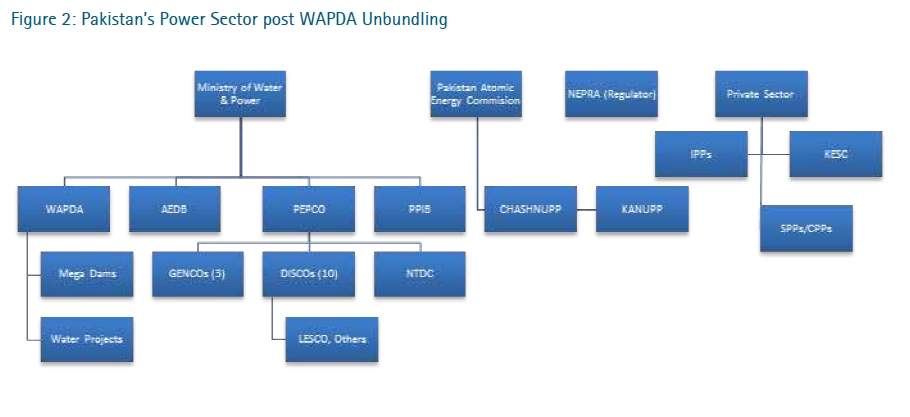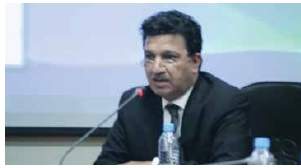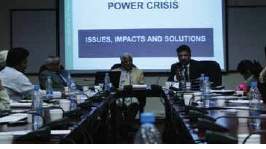
Engineer Hassan Jaffar Zaidi, CEO Power Planners International and Mr. Rab Nawaz, Secretary Energy Government of the Punjab were invited to deliver a talk on “Resolving Electricity Crisis in Pakistan: What Punjab Can Do?” at the Centre for Public Policy and Governance on October 27, 2011.
Zaidi outlined the structure of his talk to initially explore the roots of electricity crisis followed by options for Punjab to resolve the crises with reference to increased autonomy under the 18th amendment. In analyzing the basis of the energy crises, Zaidi concentrated on the supply- demand scenario, planning and governance. In terms of generation and consumption, he explained that the shift in energy mix from dominantly hydroelectric power to thermal power generation (imported oil, indigenous gas and other technologies) had gradually increased the cost of power in Pakistan and also made Pakistan dependent on international imports. The main problem though with thermal generation was the soaring oil prices as per unit kilo watt hour (KWH) cost had risen from 3.1 paisa’s in 1971 to Rs. 7.5 in 2011. The change in consumption pattern added to the problems as the 21% domestic consumption versus 42% industrial in 1980 had now gone up to 42% domestic consumption instead shifting Pakistan from productive to a consumption based society. The total power demand of Pakistan in 2009-2010 was 17,000 MW which would increase to 24,000 MW in 2014-2015 and predictably to 90,000 MW out of which 62,000 MW would be demanded by Punjab in 2030.

Discussing planning, Zaidi refuted the common perception and cliché that there was no planning regarding the power sector in Pakistan. He drew attention to the fact that a Least Cost Generation Plan (LCGP) was created with the help of experts and latest software in 1978. This was followed by a 20 year National Power Plan (NPP) prepared by WAPDA’s planning department in 1994 with the help of Canadian International Development Agency (CIDA) over a 2-3 year period. However, the plan was not implemented and only two power plants identified in the 1994 plan were setup in the subsequent 20 year period. Additionally in 1994, the Pakistan Government changed its policy to bring the power sector under the free market economy conferring a major shock to the generation planning sector. Power generation was shifted to the private sector resulting in NPP being shelved the same year it was completed. Instead Independent Power Producers (IPPs) were invited to set up power plants at sites which suited them irrespective of those selected in the plan. Thus, while IPPs continued to set up smaller plants of max 200 MW, larger public sector power projects were put on hold or blocked even on natural locations along barrages. Only a 1,400 MW hydroelectric power plant at Ghazi Barotha, which began in 1993, was successfully completed in 2003. Explaining policy implementation breakdown, he said that the National Power System Extension Plan 2030 (NPSEP) also known as the NTDC Plan 2011 had suggested construction of two 500 MW thermal power plants at Nandipur and Chichokimaliyan to stem power shortages 2007 onwards. Interestingly, the same locations had already been identified in the National Power Plan 1994. While, initially both were stalled because of a controversy regarding construction in the public or private sector. Ultimately, Nandipur project was assigned to the public sector but the government could not arrange finances to complete it while the other power plant at Chichokimaliya never took off. Instead, the interim energy policy of 2009 allowed construction of an additional plant based on oil which again increased the cost of power generation.
Further exploring the governance structure, Zaidi highlighted the unbundling of WAPDA into 14 companies with the objective of privatization. The Ministry of Water and Power was the highest authority in the command structure of the power sector which exercised direct control over Water and Power Development Authority (WAPDA), Alternative Energy Development Board (AEDB), Pakistan Electric Power Company (PEPCO) and Private Power Investment Board (PPIB). The sector’s supply chain worked such that power was generated by generation companies (GENCOs), IPPs, hydro power plants and nuclear power plants. The generated power went into the main national grid managed by the National Transmission and Despatch Company (NTDC) which was responsible for the transmission network, and also acted as the system and market operator, transmitting power to distribution companies (DISCOs). The DISCOs distributed power to the consumers, managed billing, collected the payments from consumers and paid NTDC which subsequently paid the GENCOs, who paid oil companies and other input providers. Any congestion in this cash flow system led to the accumulation of Circular Debt. Within this structure, WAPDA was only responsible for the larger dams and other water projects while PEPCO managed the GENCOs, NTDC and DISCOs. Zaidi argued that the new structure had led to bad coordination and disorganization as the newly formed private limited companies were not clear about their assigned roles and responsibilities. Though these companies had independent BoDs, they still followed directions from PEPCO. He instead suggested that the power sector should be devolved to the provinces to improve its performance.
Having reviewed and analyzed basic issues confronting the national power sector, Zaidi turned his attention towards Punjab. He stated that the Punjab Power Development Board (PPDB) and Punjab Power Development Company (PPDC) had made commendable efforts on small hydel plants having identified and issued 40 projects totaling 420 MW. The Punjab government was also encouraging coal based thermal plants to utilize coal fields in the salt range. Similarly three solar energy projects, two biogas and bagasse plants each and one solid waste plant were being executed. However, put together, these plants would generate 1,300 MW while Punjab’s predicted demand by 2030 was 60,000 MW. Thus a lot still needed to be done at the provincial level especially since the 18th amendment had lifted the 50 MW power plant cap on provincial governments. He further mentioned that though a number of IPPs had already begun small hydel power plant construction on a number of identified irrigation system sites in Punjab, hurdles still existed as distribution companies lacked the technical expertise and capacity to provide connectivity to these plants. Providing recommendations to Punjab, he articulated that the recently made National Power System Extension Plan (NPSEP) had again identified power plant sites in Punjab at Haveli and Jhang of 3,000 MW each, and Sahiwal, Bhikki and Balloki of 1,400MW each. These sites were not owned by any generation company thus allowing Punjab government to initiate work on these sites. Additionally, some locations owned by GENCOs in Faisalabad, Lahore and Shahdara had outdated and low efficiency thermal plants which should be replaced by larger and more efficient plants. He further argued that for some projects, the sites had been identified, relevant analysis conducted and investors engaged but the bureaucratic system was still an impediment, which required the Punjab government to engage stakeholders including NEPRA and DISCOs to resolve existing issues and to develop consensus.

Zaidi however did not find Punjab government’s efforts on renewable energy development as sufficient. For wind power plants, the Punjab government had only identified a few appropriate sites. Solar power generation also had a lot of untapped potential in Pakistan. Although it did not seem cost effective in the short run due to high capital costs, still it was much cheaper than oil based power in the long-run due to minimal operational & maintenance costs. Similarly, energy produced from waste was underutilized as Punjab produced great quantities of urban, industrial and agricultural waste. But a proper waste collection system and a proactive policy needed to be adopted in this regard.
“Unless there was a principle decision on decentralization of the entire system similar to that of the Indian model, it would be very difficult for provinces to take any meaningful steps on their own.”
He then proceeded to explain Punjab’s place in the power generation landscape of the country. Given that Pakistan was a longitudinal country, sites for hydroelectricity were located up in the north while thermal plants were located in the southern regions. However, 70% of the demand was concentrated in Punjab which had limited resources for power generation. According to the most recent NPSEP power plan, sites on the upper Indus, its tributaries and Jhelum tributaries mostly located in Gilgit Baltistan were identified with potentially 36,000 MW of generation capacity, while the other 40,000 MW out of the total 100,000 MW plan was based on Thar coal. Thus, post 18th amendment, provincial harmony was vital for Punjab as it was dependent on other provinces for its electricity needs.
Lastly, Zaidi made recommendations to reform the institutional structure of the power sector. Reasoning that the current NTDC load shedding plan was proportionate to the level of electricity consumption rather than the distribution company’s (DISCOs) performance leading DISCOs of Punjab to suffer excessive load shedding as compared to inefficient DISCOs, he suggested that DISCOs should directly purchase electricity from GENCOs and IPPs. NTDC should only be paid power transmission charges. PEPCO should be abolished and Central Power Purchase Agency (CPPA) should be devolved. Instead the Provincial Power Development Boards should be strengthened and empowered with the responsibility for electricity generated, sold, purchased and distributed in that province.
 Secretary Energy, Rab Nawaz opened his remarks with a warning that the country was headed towards a deeper and a more serious crisis if steps were not taken to address pivotal issues on an urgent basis. The total cost of load shedding to Pakistan’s economy was $1.5B per annum which was 2-3% of Pakistan’s GDP. A total of 400,000 (formal sector) jobs were lost along with a loss in exports of $1B. He argued that rather than generation of electricity, its affordability was the real issue. Oil was not a viable option for energy generation as continuing with the existing energy mix and its reliance on oil, Pakistan’s 2020 energy bill would include an $8B oil import bill solely for power generation. He argued that a champion was needed to clean up the mess created by strong vested interests involved in the sector.
Secretary Energy, Rab Nawaz opened his remarks with a warning that the country was headed towards a deeper and a more serious crisis if steps were not taken to address pivotal issues on an urgent basis. The total cost of load shedding to Pakistan’s economy was $1.5B per annum which was 2-3% of Pakistan’s GDP. A total of 400,000 (formal sector) jobs were lost along with a loss in exports of $1B. He argued that rather than generation of electricity, its affordability was the real issue. Oil was not a viable option for energy generation as continuing with the existing energy mix and its reliance on oil, Pakistan’s 2020 energy bill would include an $8B oil import bill solely for power generation. He argued that a champion was needed to clean up the mess created by strong vested interests involved in the sector.
Rab Nawaz challenged the view that big dams were the answer to Pakistan’s energy needs (given agriculture was their primary focus and electricity but a convenient byproduct), instead he argued that WAPDA’s policy had totally neglected run of the river projects (RORP). He contended that the Indus and its tributaries were ideal for RORPs. He pointed out that India had set up 160 RORPs ranging from 5-200 MW on the three rivers of Indus, Jhelum and Chenab using its own resources and local experts generating about 7-8,000 MW. He stated that RORP was a more practical option for Pakistan as it followed an incremental approach and cost less, while a mega project required higher funding and thus assistance from the World Bank or Asian Development Bank. He was upfront in noting that the plans to set up numerous hydel plants in Gilgit Baltistan were impractical. It was beyond Pakistani laws and to extend NEPRA or WAPDA Act to Gilgit Baltistan meant amending the regulatory framework first. Privatization was successful only in perfect markets while Pakistani markets were imperfect. In that spirit, he critiqued the decision to unbundle WAPDA into 14 companies, observing that the decision was donor driven and did not take into account what suited the country’s economic and political structure. No framework or mechanism was developed for the interaction of newly formed companies. Devoid of any accountability process in the system, there was little possibility for performance improvement. He advocated that Pakistan’s system demanded robust public sector institutions which could be held accountable.
“…energy produced from waste was under-utilized as Punjab produced great quantities of urban, industrial and agricultural waste.”
In reply to Zaidi’s suggestion that Punjab government should work on sites identified in the National Power Plan, he explained that all provincial government initiatives were circumscribed because Punjab did not have a transmission or distribution network of its own. Unless there was a principle decision on decentralization of the entire system similar to that of the Indian model, it would be very difficult for provinces to take any meaningful steps on their own. Further strengthening his argument, he agreed with Zaidi that inefficient DISCOs were being provided electricity at the cost of consumers who regularly paid their bills. Last month alone, 80% of the total collection of PEPCO was from Punjab which consumed only 60-63% of electricity. Thus, decentralization was important to improve the system. But he criticized the non-uniform privatization policy stating that only efficient DISCOs were being privatized while those unable to pay for electricity consumed were still under federal control. He additionally highlighted that the 700 MW being allocated to KESC, a privatized entity, free of cost should be checked. He also did not support NEPRA’s existing role arguing that the institution created only hurdles, instead suggesting an alternative approach that announced upfront tariffs for each technology.

In terms of alternative options, Rab Nawaz suggested the use of biomass for fuel as Punjab had an annual surplus of 45 million tons of biomass. He further indicated that twelve power plants ranging from 600 KV to 6 MW using rice husk as fuel were being put up. Also a policy had been devised for small hydel power plants whereby communities in conjunction with NGO or local firm were being encouraged and assisted to install plants on a nearby canal. A strategy in this regard still needed to be developed. Government was also promoting biogas driven power plants through employment of new designs and successful technologies from Nepal and India while biogas and wind power plants were still being assessed.
Finally, Rab Nawaz emphasized management of the existing energy crises through electricity conservation and appropriate allocation giving industrial sector the highest priority in electricity usage, and power sector a priority in the usage of gas. Both speakers recommended import of gas and coal in place of oil, supported structural reforms in the power sector and use of indigenous and renewable resources.
Citations

